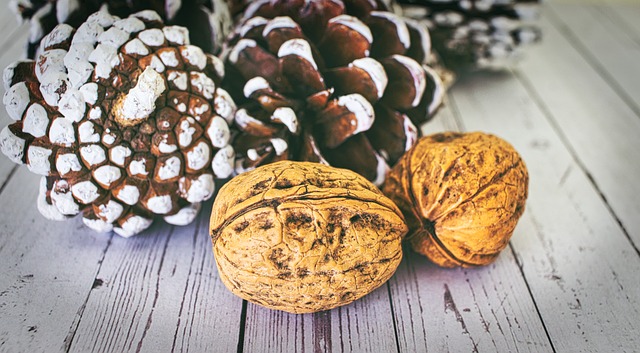Pine nuts are harvested from pinecones, hence the name. The most commonly harvested seeds come from four particular pine tree varieties.
It takes anywhere from 15 to 25 years for the trees to begin producing the seeds and up to triple that time for them to reach top production. The majority of the North American harvest comes from wild, uncultivated trees.
The seeds are mostly harvested by hand which accounts for how expensive they can be.
Health Benefits of Pine Nuts
Pine nuts are rich in Vitamins A and lutein, both of which are known to support better vision.
Pine nuts contain pinolenic acid. Recent research has shown its potential use in weight loss by curbing the appetite by the release of hunger suppressing enzymes.
They are an excellent source of:
- Vitamin E (which is an anti-oxidant)
- B-complex group of vitamins such as thiamin, riboflavin, niacin, pantothenic acid, vitamin B-6 (pyridoxine) and folates.
These vitamins work as co-factors for enzymes in cellular substrate metabolism inside the human body.
Pine nuts contain healthy amounts of essential minerals like manganese, potassium, calcium, iron, magnesium, zinc and selenium.
How To Use Pine Nuts
It is not recommended to buy pine nuts from China as they are chemically treated to extend their shelf life. Pine nuts from Italy or Spain are not treated this way and are a better choice to buy.
They contain oils which allow them to go rancid fairly quickly. This means they should be stored in the refrigerator or freezer depending on how long storage is needed.
To serve pine nuts can be toasted lightly in a frying pan without oil until golden and then added to many dishes – rice, couscous, pasta, quinoa, salad. Toasting them releases their oils and thus their flavor as well.
They are also best known for use in pesto along with basil, olive oil, salt, and garlic. (although my favorite nut for pesto is almonds).
Things to Consider About Pine Nuts
There is a syndrome called pine nut mouth which seems to be related to toxicity from ingesting the pine nuts. It is a mild form of poisoning with a syndrome called metallogeusia, which is a medical term for a bitter, metallic taste in the mouth.
It does not leave a lasting problem but usually resolves within a few days to a few weeks. Right now it seems to be linked to pine nuts coming from China. The nuts tested did not have chemicals on it so the theory is that it came from the nuts going rancid and oxidizing.
– See more at: http://medicinereport.com/article/mystery-pine-nut-mouth#sthash.ZQgEERBc.dpuf
– See more at: http://medicinereport.com/article/mystery-pine-nut-mouth#sthash.ZQgEERBc.dpuf
– See more at: http://medicinereport.com/article/mystery-pine-nut-mouth#sthash.ZQgEERBc.dpuf
– See more at: http://medicinereport.com/article/mystery-pine-nut-mouth#sthash.ZQgEERBc.dpuf
- Are Pasteurized Almonds Good or Bad? - January 31, 2022
- Nutrition of Peanuts - November 20, 2013
- Happy With Hickory Nuts - November 13, 2013



I’ve definitely experienced pinenut mouth!! It doesn’t happen every time (interesting theory!) but for a while I was making my pesto with walnuts. Thanks for linking up to Wellness Wednesday!
wow, someone who has been through this. So it is probably more common than we realize.